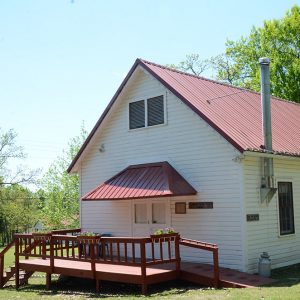calsfoundation@cals.org
Coal Gap School
The Coal Gap School building is located in rural Benton County, approximately fifteen miles east of Rogers (Benton County). This is the third building in this location and sited near the two earlier sites. The origin of Coal Gap’s name is unknown, but it was possibly once known as Jennings Switch. The Coal Gap School was listed on the National Register of Historic Places on September 4, 1992, and is privately owned.
Benton County records contain a list of school directors at the office of the county school supervisor’s office and state they were “elected by 1887,” indicating the first Coal Gap/Jennings Switch school’s existence at that time. Edmond L. Jennings received 160 acres on May 15, 1876, as part of the Homestead Act of 1862. A son, John Jennings, inherited it in 1900, and he deeded one and three-fourths acres to School District 105 for $1.00—as long as it was used for a school.
Students quenched their thirst at a well near the big oak trees. Navigating to the woods, they played on big rocks at recess. Students brought their lunches to school with them. In the early days, the White River meandered through the valley, not far below the school. Jennings Ford Road ran in front of the school southward to White River, where Jennings Ferry carried people across White River to Rocky Branch (Benton County) and Larue (Benton County), and travelers used Blackburn Mill Road toward War Eagle Mill. After the ferry disappeared, people crossed the river by wagon, horse, or boat.
The second version of Coal Gap School was a two- story wooden structure, but the building was moved several yards south in the 1930s and used as a barn until Beaver Lake claimed it. In all three of the buildings, eight grades were taught.
The current surviving building was constructed around 1928. It is a rectangular one-story white wood-frame building with five narrow windows along both the north and south sides. Originally, a school bell was in the building, but it was removed when the school closed. In 2021, it was returned to the Glade Community Historical Society Museum and sits in a bell tower across the road from the schoolhouse.
Coal Gap teachers lived nearby or traveled the rough, unpaved roads to the school. Terms were often short, depending on community funds. Coal Gap School was the community hub where church and social meetings were held. Board members were elected from community residents. In early years, some students repeated the eighth grade to reinforce their learning, since farm families could not afford the cost for their youngsters to attend high school in Rogers. During the Great Depression, the Works Progress Administration (WPA) built two new outdoor toilets across Slate Gap Road. Both have since collapsed.
The school closed on January 20, 1949, upon petition of both Coal Gap and Garfield (Benton County); the Benton County Board of Education agreed to dissolve Coal Gap School District No. 105 and consolidate it with Garfield District No. 114. But on March 5, 1949, Garfield School District No. 114 was dissolved and annexed to Rogers School District No.30. Children of both Coal Gap and Garfield districts were to attend the Garfield School through the sixth grade, while junior and senior high students were bused into Rogers.
Coal Gap School was annexed four years after the Glade Post Office closing. The damming of the White River creating Beaver Lake was progressing, and the lake opened in 1966. Old roads to Rogers that crossed Cedar and Ford’s Creek to reach Highway 12 disappeared under the lake, and Highway 127 became the only route to Garfield and towns beyond. Eminent domain pushed residents of Glade into new homes elsewhere. Soon, improved roads appeared for vacation and residential homes, and the landscape changed as the farmland disappeared under the lake.
In the twenty-first century, a marker stands on Jennings Ford Road and can be viewed below Coal Gap School and the Glade Museum. The museum, formerly the Glade Post Office building, stands across Jennings Ford Road at Coal Gap School.
For additional information:
“Coal Gap School.” National Register of Historic Places nomination form. On file at Arkansas Historic Preservation Program, Little Rock, Arkansas. Online at https://www.arkansasheritage.com/arkansas-historic-preservation-program (accessed May 8, 2024).
Patricia Williams Heck
Glade Community Historical Society
 Early Twentieth Century, 1901 through 1940
Early Twentieth Century, 1901 through 1940 Education, Elementary and Secondary
Education, Elementary and Secondary Historic Preservation
Historic Preservation Coal Gap School
Coal Gap School 



Comments
No comments on this entry yet.